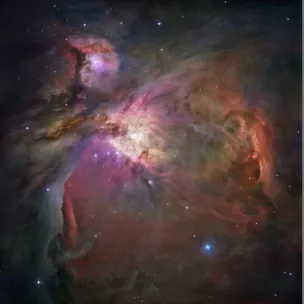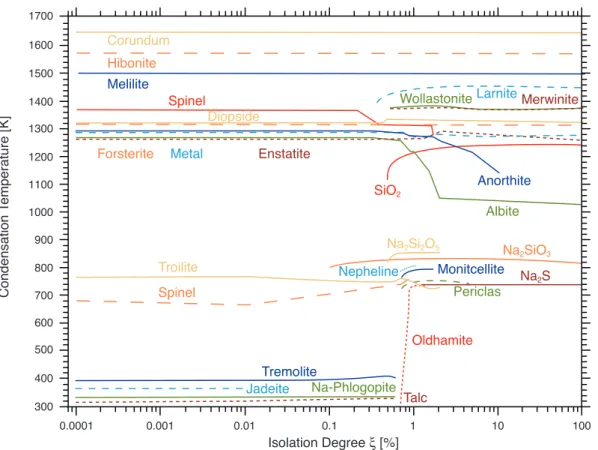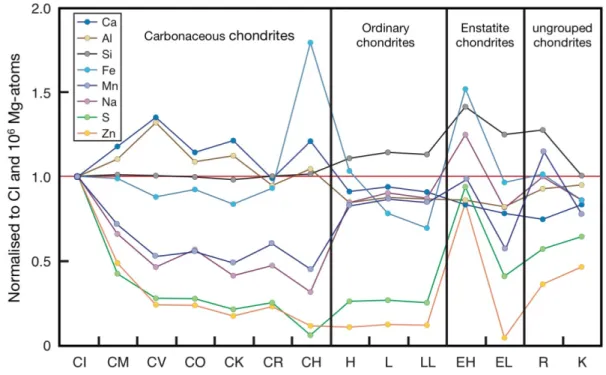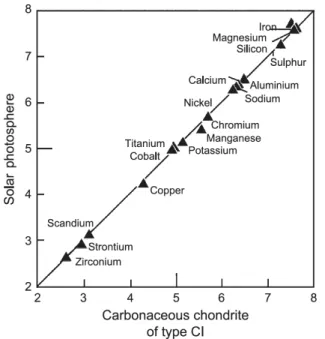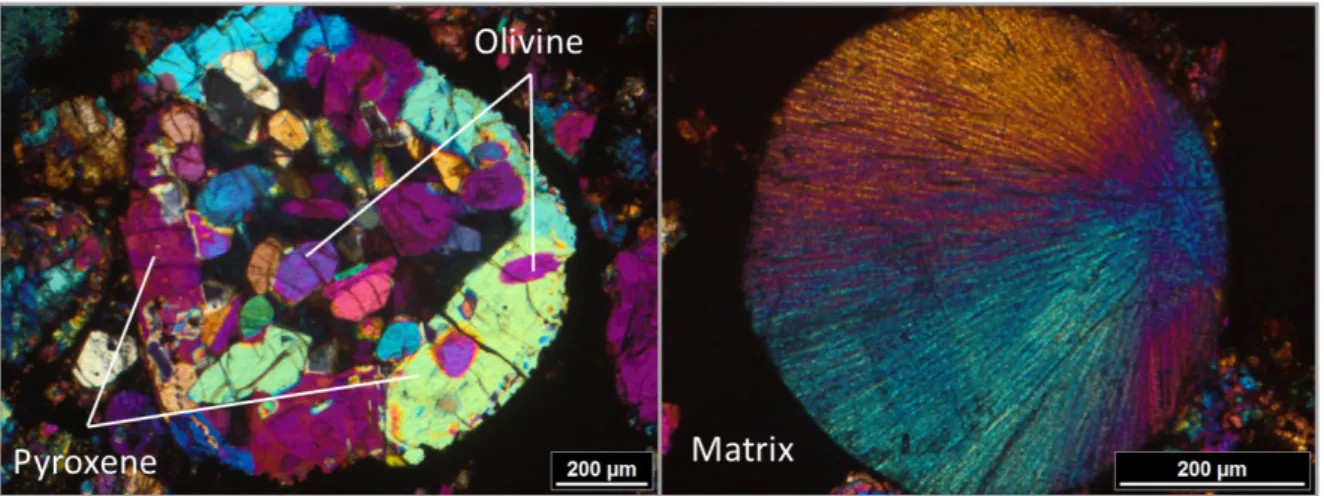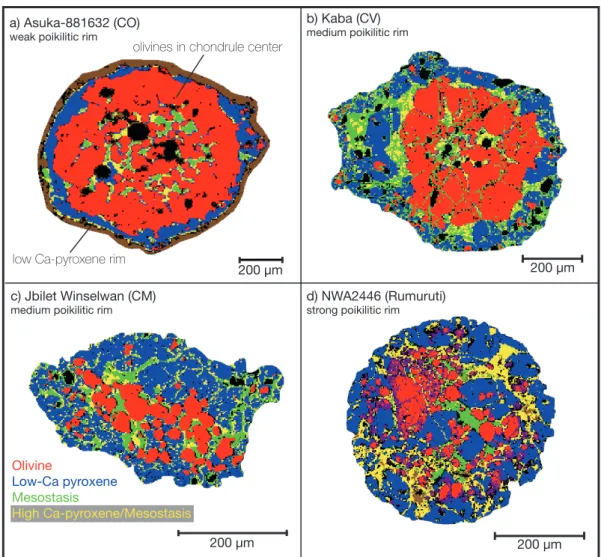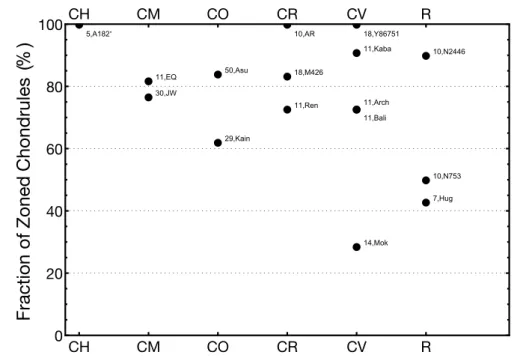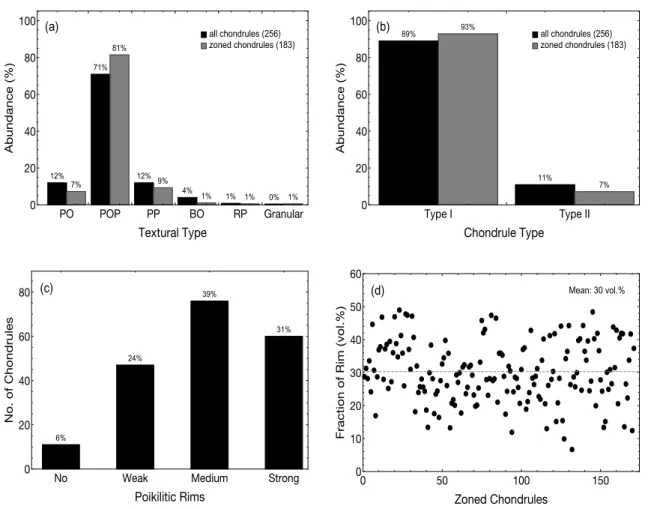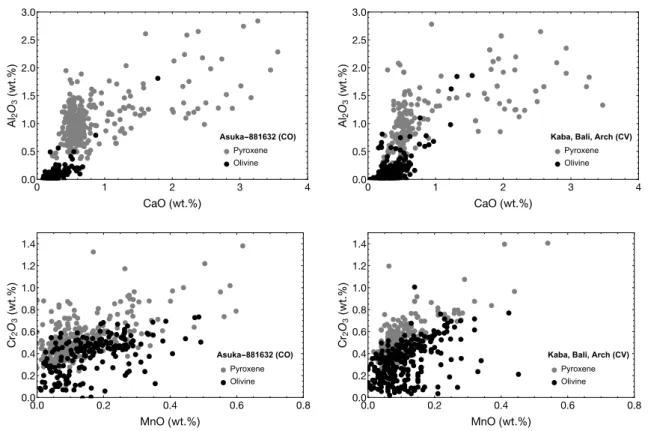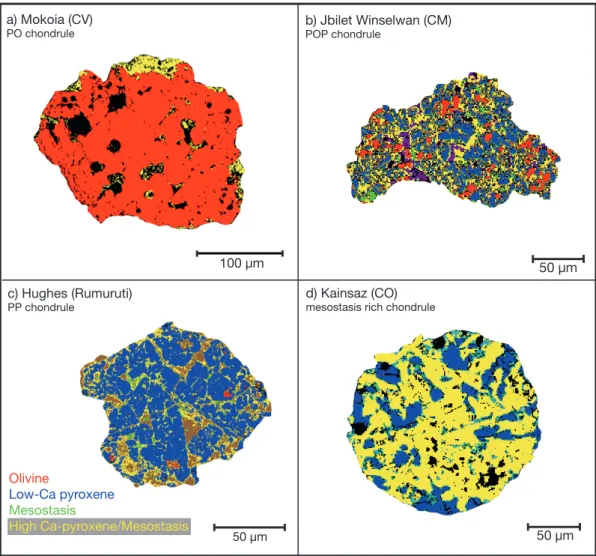chondrule-matrix complementarities in carbonaceous and Rumuruti chondrites
I n a u g u r a l - D i s s e r t a t i o n zur
Erlangung des Doktorgrades
der Mathematisch-Naturwisschenschaftlichen Fakultät der Universität zu Köln
vorgelegt von Pia Friend aus Solingen
Köln 2017
Berichterstatter: PD Dr. Dominik Hezel Prof. Dr. Carsten Münker
Tag der mündlichen Prüfung: 07.07.2017
“The more clearly we can focus our attention on the wonders and realities of the universe about us,
the less taste we shall have for destruction.”
-Rachel Carson
Abstract ... 1
Kurzzusammenfassung ... 2
1 Introduction ... 3
1.1 The solar system ... 4
1.1.1 Structure of the solar system ... 4
1.1.2 Formation of the solar system ... 5
1.2 Chondrite classification and components ... 9
1.2.1 Chondrite classification ... 9
1.2.2 Chondrite components ... 13
1.3 Chondrule formation ... 16
1.4 Aims and objectives ... 19
2 The conditions of chondrule formation, Part II: Open system ... 21
Abstract ... 22
2.1 Introduction ... 23
2.2 Methods ... 25
2.3 Results ... 27
2.4 Discussion ... 33
2.4.1 Formation of low-Ca pyroxene rims ... 33
2.4.2 Amount of material added to the chondrules ... 35
2.4.3 Chondrule sizes and bulk compositions ... 35
2.4.4 Unzoned chondrules ... 36
2.5 Conclusions ... 38
References ... 41
3 Chondrule and matrix complementarities in the recently discovered Jbilet Winselwan CM chondrite ... 47
Abstract ... 48
3.1 Introduction ... 49
3.2 Methods ... 52
3.3 Results ... 54
3.3.1 Textures and lithologies of Jbilet Winselwan ... 54
3.3.2 Bulk chondrite composition ... 58
3.3.3 Petrography and elemental composition of chondrules ... 59
3.3.4 Petrography and chemical composition of matrix and fine-grained chondrule rims 61 3.4 Discussion ... 63
3.4.1 Jbilet Winselwan bulk composition ... 63
3.4.2 Aqueous alteration of JW ... 65
3.4.3 Fine-grained chondrule rims ... 66
3.4.4 Complementarities ... 67
3.5 Conclusions ... 71
References ... 74
Supplementary ... 81
4 Complementary element relationships between chondrules and matrix in Rumuruti chondrites ... 84
Abstract ... 85
4.2.2 Methods ... 88
4.3 Results ... 90
4.3.1 Petrography ... 90
4.3.2 Bulk composition of NWA 753 ... 92
4.3.3 Major elements (Fe, Mg, Si) and refractory elements (Al, Ti, Ca) in chondrules and matrix 93 4.4 Discussion ... 96
4.4.1 Petrologic types of investigated fragments ... 96
4.4.2 Complementarity of major elements (Fe, Mg and Si) ... 97
4.4.3 Complementarity of refractory elements (Al, Ti and Ca) ... 98
4.4.4 Origin of major element complementarities ... 99
4.4.5 Addition of Si in bulk R chondrites ... 100
4.4.6 Origin of refractory element complementarities ... 102
4.5 Conclusions ... 102
References ... 105
Supplementary ... 109
5 Discussion ... 112
5.1 Possible mechanisms of complementarities ... 114
5.1.1 Condensation, evaporation and recondensation ... 114
5.1.2 Separation of metal from chondrules ... 116
5.1.3 Differences among precursors and sorting between chondrules and matrix ... 116
5.2 Complementarity and chondrule formation processes ... 117
5.3 Conclusion ... 119
References for chapter 1 and chapter 5 ... 120
List of abbreviations ... 131
Danksagung ... 133
Erklärung zum Eigenanteil an den Publikationen ... 135
Erklärung ... 136
Lebenslauf ... 137
Abstract
Chondritic meteorites (´chondrites`) are primitive early solar system materials; the composition of chondrites—especially of CI chondrites—represent the average solar system composition. The two main components of chondrites are (i) chondrules, µm to mm-sized silicatic melt droplets, and (ii) matrix, an opaque and fine-grained unequilibrium mineral assemblage. The origin of these two constituents, especially for the heat source required for melting chondrules, is still enigmatic. In this work, the genetic link between chondrules and matrix was studied.
A mineralogical zonation with olivine minerals dominating the cores and low-Ca pyroxenes at the margins are present in at least 75% of all chondrules studied in chapter 2.
In total, 256 chondrules of 16 different carbonaceous and Rumuriti chondrites (R chondrites) were studied. The low-Ca pyroxene rims were formed by addition of Si to the chondrules (or their precursor) from the surrounding nebula gas, which later condensed to form matrix.
Hence, chondrules were open systems and gained 3-15 wt.% material by this process.
In chapters 3 and 4, bulk chondrule, matrix and bulk meteorite compositions of the recently found CM chondrite Jbilet Winselwan (JW) and of three different R chondrites were studied. Bulk chondrule and matrix compositions were obtained with the electron microprobe and bulk meteorite compositions with X-ray spectrometry.
Jbilet Winselwan and the R chondrites show chemical complementarities. Thus, although bulk meteorite compositions are CI chondritc (=solar), chondrules and matrix have different compositions. The amount of matrix in the studied chondrites are at least 50 vol.%. All chondrites have higher than bulk ratios of Fe/Mg, Si/Mg, Al/Ti, Al/Ca in the matrices and vice versa in chondrules. Bulk chondrite ratios are (except Si/Mg in R chondrites) CI chondritic. These complementarities, together with the solar bulk composition of the meteorites, can only be explained when chondrules and matrix formed from a single reservoir.
In chapter 4, complementarity is, to my knowledge, for the first time reported in non-
carbonaceous chondrites. It is assumed that carbonaceous and non-carbonaceous chondrites
formed in distinct regions within the solar system. A joint formation of chondrules and
matrix is required for both reservoirs.
Kurzzusammenfassung
Chondritische Meteorite („Chondrite") sind primitive Materialen aus dem frühen Sonnensystem. Ihre Zusammensetzung (insbesondere der CI-Chondrite) repräsentiert die durchschnittliche Zusammensetzung des Sonnensystems. Die beiden Hauptkomponenten der Chondrite sind (i) Chondren, µm bis mm-große, silikatische Schmelztröpfchen, und (ii) Matrix, ein opakes und feinkörniges Mineralgemisch. Die Entstehung beider Komponenten, insbesondere der Urspung der Hitzequelle welche die Chondren zum Schmelzen brachte, ist unbekannt. In dieser Arbeit wurde der genetische Zusammenhang zwischen Chondren und Matrix untersucht.
Eine mineralogische Zonierung mit überwiegend Olivinen in den Chondrenzentren und Ca-armen Pyroxenen in den Rändern sind in mindestens 75% der in Kapitel 2 untersuchten Chondren zu finden. Insgesamt wurden 256 Chondren in 16 verschiedenen kohligen sowie Rumuruti Chondriten (R Chondrite) untersucht. Die Pyroxene der Chondrenränder bildeten sich durch Aufnahme von Si aus dem umgebenden Gas, welches später zu Matrix kondensierte. Chondren (oder ihre Vorläufer) fungierten als offene Systeme und erhielten auf diese Weise eine Massenzunahme von 3-15 Gew.%.
In den Kapiteln 3 und 4 wurden mit der Elektronenestrahlmikrosonde die chemische Zusammensetzung von Chondren und Matrix des CM Chondriten Jbilet Winselwan (JW), sowie dreier R Chondrite bestimmt. Die jeweiligen Gesamtgesteinszusammensetzungen der Meteorite wurden außerdem mittels Röntgenfluoreszenzspektrometrie analysiert.
Die untersuchten Chondrite haben mindestens 50 Vol.% Matrix. Die Matrices der Chondrite haben erhöhte Verhältnisse von Fe/Mg, Si/Mg, Al/Ti und Al/Ca gegenüber den Gesamtmeteoriten; Chondren haben entsprechend niedrigere Verhältnisse. Die Gesamt- zusammensetzung der Meteorite ist (bis auf Si/Mg in den R Chondriten) CI-chondritisch (solar). Diese komplementären Zusammensetzungen können im Zusammenhang mit den solaren Elementhäufigkeiten der Meteorite nur erklärt werden, wenn sich Chondren und Matrix gemeinsam im gleichen Reservoirs gebildet haben.
In Kapitel 4 wird, zu meinem Wissen, Komplementarität das erste Mal in nicht-kohligen
Chondriten beschrieben. Es wird vermutet, dass kohlige und nicht-kohlige Chondrite aus
unterschiedlichen Regionen des frühen Sonnensystems stammen. Eine gemeinsame Bildung
von Chondren und Matrix muss in beiden Reservoiren angenommen werden.
1 Introduction
Meteorites are extraterrestrial lithic fragments that enter Earth`s atmosphere and strike its surface.
Witnesses that meteorite impacts have always been a part of the Earth are e. g. fossilised meteorites, impact features such as the Chicxulub crater underneath the Yucatan peninsula, or ancient chronicles from China or Crete about meteorite showers. However, in 1794, the German polymath Ernst Chladni realised the extraterrestrial origin of meteorites and thereby laid the foundation for modern meteorite studies.
Most meteorites are found in deserts, because the dry climate prevents extensive weathering and dark rocks are easily visible on light desert ground. Another advantage for finding meteorites in cold deserts is, that meteorites accumulate in response to ice movements. The ice moves until reaching areas with relatively low accumulation but high sublimation rates. Those snow free places, are called ´Blue Ice` areas, because they expose the deeper glacial ice. Meteorites which were carried within the ice remain there after the ice ablated. The Antarctic Search for Meteorites (ANSMET) organises expeditions to those meteorite traps since 1976, and more than 30,000 Antarctic meteorites have been found so far. In 1984, the first lunar rock was discovered and, ten years later, the first Martian rock. However, beside very few samples from Moon and Mars, the vast majority of meteorites that are found on Earth are debris from asteroids. They originate in the asteroid belt, which is located between the planets Mars and Jupiter. Based on whether a meteorite is composed of stone, iron, or stone-iron, two basically distinct types of asteroids are distinguished: (i) differentiated bodies, which became heated and molten, differentiated, and re- solidified after formation, and (ii) undifferentiated asteroids, which were not molten after their accretion and agglomeration in the protoplanetary disc. Meteorites from differentiated bodies are referred to as ´achondrites` and undifferentiated meteorites are called ´chondrites`. The latter are the focus of this work.
The undifferentiated chondrites directly sample the solar nebula (protoplanetary disc), which
existed about 4.57 billion years ago (Bouvier and Wadhwa, 2010) and mark the beginning of our
solar system. Hence, they record the physical and chemical conditions in the solar nebula.
1.1 The solar system
1.1.1 Structure of the solar system
Our solar system consists of a central star —the Sun— and eight planets, that orbit the Sun in the same plane (ecliptic) (Fig.1.1). The Sun contains 99.9% of the mass of the solar system (Woolfson, 2000). Hence, the composition of the Sun is representative of the entire solar system.
The Sun consists of roughly 99 wt.% of H (~75 wt.%) and He (~24 wt.%), and only less than 2 wt.% of elements heavier than He (Lodders, 2003). As a lower main-sequence star, in its core He is generated by fusion reaction of H, but heavier elements are not produced. Closest to the Sun are the four terrestrial planets of the inner solar system: Mercury, Venus, Earth, and Mars. These, also called ´telluric` or ´rocky` planets, are mainly composed of silicate rocks and metal. Their mean densities are between 5.4 (Mercury) and 3.9 g/cm
3(Mars) and decrease with increasing distance from the Sun. They are composed of at least two layers: an inner core consisting mainly of Fe and Ni plus minor amounts of other siderophile (iron-loving) elements, and an outer shell that is built up mainly from lithophile (stone-loving) elements, which commonly form silicates.
The distance between Sun and Earth is about 150 x 10
6km, defining 1 AU (Astronomical Unit).
Adjacent to the inner solar system, from about 2.0 to 3.4 AU, extends the asteroid belt, which is populated with asteroids and dwarf planets. So far, the orbits of more than 600,000 objects have been recorded in the asteroid belt. Only a few of those objects are more than 100 km in diameter and their total mass is estimated to be about 1/2000 of that of Earth (Chambers, 2014). The
Figure 1.1: Model of the solar system.
(Image credit: NASA`s the Space Place, via http://spaceplace.nasa.gov/ice-dwarf/)
composition of these objects is not uniform throughout the main asteroid belt. The inner asteroid belt, up to 2.5 AU, is dominated by silicate rich objects which have at some time been partially or even completely molten. At a distance of 2.5 AU the darker and carbon richer objects dominate, which have not, or only mildly, been heated. Behind the asteroid belt lies the outer solar system with the Jovian planets: Jupiter, Saturn, Uranus, and Neptune. These gas giants consist mainly of H and He and their densities are between 0.7 and 1.6 g/cm
3. Beyond the orbit of Neptune, between 30 and 50 AU, are the objects of the Kuiper belt. The Kuiper belt consists mainly of small objects, which are less than 100 km in diameter, but is also home of three officially recognised dwarf planets—Pluto, Haumea, and Makemake. Additionally, most comets are assumed to originate from the Kuiper belt. Behind the Kuiper belt assumably lies the Oort cloud. The Oort cloud is a hypothetical, and so far, not detected accumulation of astronomic objects in the outermost parts of the solar system.
1.1.2 Formation of the solar system
The formation of our solar system and its planetary system is a long-standing question and not yet completely solved. Clues about its formation is basically provided from astronomical observations, cosmochemical studies of meteorites and space missions (Chambers, 2014). Based on these observations, the picture about the formation of the Sun and the planets is constantly refined. I will outline here the basic steps of the beginning and the formation of the solar system.
The birth of our solar system started in a huge molecular cloud. Molecular clouds are cold and dense (T ~10 K; n
H2~ 100 cm
3) regions in a galaxy (Ostriker et al., 2001). They consist primarily of molecular hydrogen, mixed with traces of interstellar dust grains and rare organic as well as inorganic molecules (Alves et al., 2001). The largest molecular clouds are visible to the naked eye, appearing as dark patches against a brighter background in the Milky Way. One present region of such a massive star formation in the Milky Way is the Orion Nebula, which is 1,344±20 light years away from Earth (Hirota et al., 2007) (Fig. 1.2).
Figure 1.2: Thousands of stars are forming inside
the Orion Nebula. (Image credit: NASA/ESA, via
http://spacetelescope.org/.)
Such stellar nurseries can contain thousands of young stars and extend hundreds of light years across.
The molecular cloud from which our solar system formed existed for an unknown time, until it collapsed, probably initiated from the shock front of a nearby supernova explosion. The cloud contracted and most of its mass fell into the centre to form the protosun. Due to collapsing, the gravitational potential energy of the cloud was converted into kinetic energy of individual particles. This results in increased collisions of the particles and the kinetic energy was converted into heat. The disc became hottest in its centre, where most of the mass was concentrated in the Protosun. The temperature decreased with increasing distance from the centre. When temperatures in the protosun were as high as 10
6K, nuclear reactions started and the Sun was born, surrounded by a rotating disk. This protoplanetary disk is here called ´solar nebula`. The solar nebula probably lasted for a few million years, until the planets, their moons, the dwarf planets, the asteroids and the comets had finally formed.
When the inner disk cooled, the first solid matter formed as µm sized objects by condensation.
The predicted condensation sequence in a gas of solar composition at pressures of 10
5bar is shown in Fig. 1.3 (Petaev and Wood, 1998). On the x-axis of the diagram, the ´isolation degree`
(ξ) is given. This variable indicates how much of the already condensed matter is continuously withdrawn from reactive contact with the surrounding gas while condensation proceeds. Hence, at the lower end of the x-axis, condensation under equilibrium condition (ξ=0) is displayed, while the rest of the diagram shows condensation with variable degrees of fractionation. The first minerals to form in a cooling gas of solar composition are at temperatures of about 1700 K Ca,Al- rich oxides. These phases make less than 5 % of the total condensable matter (Palme, 2000).
With decreasing temperatures, the first silicate to form, slightly above 1300 K, is diopside (CaMgSi
2O
6), followed by forsterite (Mg
2SiO
4). Metal, as well as small amounts of anorthitic plagioclase (CaAl
2Si
2O
8), start to form at about 1300 K. The composition of the solar nebula is highly reducing and metallic Fe,Ni-phases are the stable condensed form of iron until temperatures of below 800 K (Grossmann et al., 2008). Under equilibrium condensation, also forsterite reacts with gaseous SiO to form enstatite (MgSiO
3) and pure anorthite has been converted to pure albite (NaAlSi
3O
8), just below 1300 K. As Fe, Mg and Si are the three most abundant elements heavier than oxygen, in the solar nebula, the largest fraction of condensable matter is incorporated into those minerals that condense at temperatures above 1200 K.
The moderately volatile elements, which were not already incorporated into previously
formed minerals, such as e.g. Na in Albite, start to condense at temperatures below 800 K.
Sulphur is the most abundant of these moderately volatile elements and condenses by reaction with solid Fe to form sulphides. Under equilibrium condition, other moderately volatile elements condense in solid solution with existing silicates, metal, or sulphide major phases.
Under fractionated condensation, with isolation degrees of ξ >0.1 %, the condensation sequence changes substantially (Fig.1.3). Values of ξ between 0.1 and 2.5 seem reasonable to produce the mineral assemblages found in chondrites (Pateav and Wood, 1998).
Accretion of material started already during the formation of the first tiny grains by condensation in the solar nebula. Small amounts of presolar grains were also present in the solar nebula and coagulated with the early condensates. The initial stage of accretion was due to Van der Waals forces, during collisions of the orbiting grains. When particles reach a size of mm or cm, growth is likely to stagnate (Brauer et al., 2008; Zsom et al., 2010), referred to as the ´meter size barrier`. The mechanism which was responsible for the formation of planetsimals remains unclear (Chambers, 2008). However, when planetesimals had once formed, further growth was first mainly due to gravitational focusing (´runaway accretion`) and later dominated by oligarchic growth when collisions became more destructive. Both mechanisms lead to increased accretion
Corundum Hibonite Melilite
Larnite
Wollastonite Merwinite Spinel
Tremolite
Anorthite
Na-Phlogopite
Albite SiO2
Oldhamite
Talc Enstatite
Metal
Jadeite Forsterite
Spinel
Diopside
Troilite
Periclas Na2S Nepheline Monitcellite
Na2Si2O5 Na2SiO3
0.001 0.01 0.1 1 10 100
0.0001 500 1700 1600 1500 1400 1300 1200 1100 1000 900 800 700 600
400 300
Condensation Temperature [K]
Isolation Degree ξ [%]
Figure 1.3: Condensation temperatures in a gas of solar composition at a pressure of 10-5 bar depending on the isolation degree (ξ). Major changes in the condensation sequence take place at isolation degrees between 0.1 and
1 %. (Figure after Petaev and Wood, 1998).
rates of larger bodies compared to smaller ones. When planetary embryos had formed, each one had its own annular feeding zone. The temperature gradient away from the Sun in the protoplanetary disc is thereby reflected in the composition of bodies in the different parts of the solar system.
Bodies with a particular diameter or which formed very early got heated, melted and differentiated due to energy that was generated by impacts and the decay of radioactive isotopes such as the short-lived isotope
26Al (Fig. 1.4). Siderophile elements formed the cores, while lithophile elements accumulated in silicates and formed the mantles and potential crusts of planetesimals. This structure is typical of the terrestrial planets. The main asteroid belt is populated by small bodies, which are mostly unfractionated. Yet, some meteorites derive from differentiated asteroids. These achondrites consist either of the metallic cores, or the olivine-rich mantles, or both, of their parent bodies. Isotope studies on some iron meteorites reveal very old formation ages within 2 Myr after formation of the solar system (Kleine et al., 2005; Markowski et al., 2006, Schersten et al., 2006). Hence, they formed early enough to sustain sufficient amounts of
26Al for melting. However, most meteorites derive from undifferentiated bodies: the
´chondrites`, which represent about 86% of all known meteorites. These objects still contain the solids that have formed at the beginning of our solar system. Chondrites are therefore direct samples of the solid fraction of the solar system and, hence, provide unique insights into its chemical and physical evolution.
Figure 1.4: Differentiation process: an undifferentiated asteroid gets heated caused largely by the decay of
26Al . Lithophile elements differentiate into silicates and form the mantle and siderophile elements form the core.
Chondrites derive from undifferentiated asteroids.
1.2 Chondrite classification and components
1.2.1 Chondrite classification
Classification according to primary classification parameters
Primary classification parameters for chondritic meteorites are their oxygen isotope composition, their bulk chemistry, as well as their petrology and petrography. Based on these parameters, chondritic meteorites are divided into classes, clans and groups (Fig.1.5). The purpose of this classification is to sort the meteorites according to generic similarities, e. g. the same time or same location of formation in the solar nebula or even a common parent body (Krot et al., 2014).
There are 3 classes among the chondritic meteorites: ordinary (O), carbonaceous (C), and enstatite (E) chondrites. The chondrites of each class can be charted in a three-oxygen isotope diagram (Fig. 1.6), or on diagrams representing the bulk chemical compositions of the meteorites (Fig. 1.7).
The classes are subdivided into clans. Clans unite chondrite groups, which are similar regarding to their chemical, mineralogical and/or isotopic properties; yet have petrologic and/or bulk chemical different characteristics. Meteorites of the same clan may have originated at about the same time and in the same region of the solar nebula (e.g. Kallemeyn et al, 1996).
A group consists of at least 5 individual chondrites, which have closely similar whole-rock chemical and oxygen isotope characteristics, and common petrologic features, such as chondrule sizes, chondrule/matrix ratios and mineral compositions. Chondrites of one group have probably originated from the same parent body. Main petrographic characteristics of the individual chondrite groups are listed in Table 1.
Figure 1.5: Classification scheme of chondrites after Weisberg et al. (2006).
The eight groups of the C chondrites commonly contain rather high percentages of matrix, often with chondrule/matrix ratios around 50:50 (Scott et al., 1996), except CI chondrites which are almost completely composed of matrix. Oxygen isotope compositions of the C chondrites plot typically below the terrestrial fractionation line (TFL), except for CI chondrites. The group of CI chondrites represent the most primitive chondrites, with chemical compositions that are identical to the solar photosphere for all but the highly volatile elements (e. g. Anders and Grevesse, 1989, Lodders 2003, Palme et al., 2014a) (Fig. 1.8). Because of the equal compositions of CI chondrites and the solar photosphere, CI chondrites are used as a reference composition for many solar system materials. Figure 1.7 shows bulk element data of chondrite groups normalised to CI chondrites and to Mg. Other groups of C chondrites are enriched in refractory elements by factors 1.0 to 1.4 and depleted in moderately volatile elements, relative to CI chondrites (Scott and Krot,
Figure 1.6: Oxygen isotope composition of bulk-rock chondrites. (Data from Clayton and Mayeda, 1996; 1999; Clayton et al., 1991; Clayton, 2003; and references therein)
Figure 1.7: Element abundances in chondrite groups normalised to CI chondrites and Mg. (Data from Wolf and
Palme, 2001; and refences therein).
2003). The major elements Si, Mg and Fe are largely unfractionated among the C chondrites.
The O chondrites are with > 80% the most abundant class of meteorites. Their oxygen isotope compositions plot above the TFL on a three-isotope diagram. They generally contain large amounts of chondrules (60-80 vol.%) and opaque phases (7-15 vol.%) but only few amounts of matrix (<15 vol.%) (Scott and Krot, 2003; and references therein). Their subdivision is based on bulk Fe contents (H= high total Fe; L=low total Fe) and oxidation state (LL= low total Fe and low abundance of metal). Ordinary chondrites are depleted in refractory elements and moderately volatile elements. Silicon and Mg are slightly enriched in all O chondrites, but Fe is enriched in H, and depleted in L and LL Ordinary chondrites with respect to CI chondrites.
Enstatite chondrites are highly reduced, with virtually all iron occurring as metal and sulphides. They contain only little matrix material, up to 15 vol.% (Scott et al., 1996). Their oxygen isotopes plot on the TFL in a three-isotope diagram. The group of EH chondrites is characterised by high total Fe and the EL chondrites by low total Fe contents. Silicon is generally enriched in E chondrites, while Ca and Na are enriched in EH, but depleted in EL chondrites, with respect to CI. The refractory element Al as well as the moderately volatile elements Mn, S, and Zn are slightly depleted in EH chondrites and more depleted in EL, compared to CI.
The Rumuruti (R) and Kakangari (K) chondrites have considerable amounts of matrix, roughly between 40 and 50 vol.% in R chondrites (Bischoff et al., 2011) and up to 70 vol.% in K chondrites (Weisberg et al., 1996). Oxygen isotope data plot above the TFL for R chondrites and below the TFL for K chondrites. In both chondrite groups, bulk rock element data show depletions in refractory and moderately volatile elements, relative to CI chondrites. In R chondrites, Si is enriched, but Mg and Fe are unfractionated. In K chondrites, Fe is depleted, but Si and Mg are unfractionated.
There exist also several mineralogically and/or chemically unique chondrites, which cannot be charted among the existing groups. Those are referred to as ungrouped chondrites.
Figure 1.8: Major and trace element abundances of CI
chondrites are identical to the composition of the solar
photosphere. (Figure from Zanda, 2004)
Data are from Krot et al. (2014); except abundance data for CAIs, which are from Hezel et al. (2008) and reverences therein.
Classification according to secondary classification parameters
Chondrites are primitive solar system materials that originate from unfractionated parent bodies.
However, individual chondrites may have undergone secondary alteration processes. Post- accretionary processes are an additional classification parameter for chondrites.
The classification scheme introduced by Van Schmus and Wood (1967) divides chondrites into petrologic types, depending on the degree and nature of secondary alteration that the meteorite experienced on its parent body. This classification is based on mineralogical changes, which occur due to thermal or aqueous alteration. Chondrites of petrologic type 3 represent the least altered material, which have not undergone chemical equilibration processes due to aqueous or thermal overprint. Type 1 and type 2 chondrites underwent aqueous alteration, with the degree
Main petrographic characteristics of the distinct chondrite groups.
CAIs (area%)
Chondrules (vol.%)
Matrix (vol.%)
Metal (vol.%)
Chondrule mean Ø (mm)
Petrologic types
CarbonaceousCI <<1 <<1 >99 0 - 1
CM ~1 20 70 0.1 0.3 1-2
CO ~1 48 34 1-5 0.15 3-4
CR ~0.1 50-60 30-50 5-8 0.7 1-2
CH 0.1 ~70 5 20 0.02 3
CB <0.1 30-40 <5 60-70 0.1-20 3
CV ~3 45 40 0-5 1 3-4
CK 0.2 15 75 <0.01 0.7 3-6
Ordinary
H 0.01-0.2 60-80 10-15 ~8 0.3 3-6
L <0.1 60-80 10-15 ~4 0.7 3-6
LL <0.1 60-80 10-15 2 0.9 3-6
Enstatite
EH <0.1 60-80 <0.1 ~10 0.2 3-6
EL <0.1 60-80 <0.1 ~10 0.6 3-6
Additional
R <0.1 >40 30 <0.1 0.4 3-6
K <0.1 ~30 60 ~7 0.6 3
of alteration decreasing from 1 to 2. Type 4 to type 6 chondrites experienced thermal metamorphism of increasing degree from 4 to 6. Typically, carbonaceous chondrites mostly experienced aqueous alteration, with CI chondrites always being of petrologic type 1. The O, E, R and K chondrites are always of petrologic types 3 to 6. The range of petrologic types, which occur in the different chondrite groups is displayed in Table 1. Many chondrites are brecciated rocks (e. g. Bischoff et al., 1983; Bischoff et al., 2011) and their different fragments may have experienced various extents of asteroidal processes. Hence, it is not always possible to label a chondrite with a single petrologic type, and different fragments must be classified individually.
Another secondary classification parameter is the shock stage which indicates the grade of shock pressure that a meteorite experienced during impacts on its parent body. The classification is based on shock effects observed in olivine and plagioclases (Stöffler et al., 1991) or in low-Ca pyroxenes (Rubin et al., 1997). The classification scheme range from S1 (unshocked) to S6 (very strongly shocked).
The degree of terrestrial weathering of individual meteorite finds can also be specified.
According to Wlotzka (1993) the progressive alteration stages are from W0 (no visible alteration of minerals) to W6 (massive replacement of primary minerals).
1.2.2 Chondrite components
The main components of chondrites are chondrules, matrix, opaque phases and refractory inclusions (Fig.1.9).
Chondrules are, together with matrix, the dominant and most prominent component of chondritic meteorites. They are solidified molten spherules, which are normally between 400 µm and 1 mm in size. Chondrules are no direct condensates, but formed from molten precursor material. Major minerals of chondrules are olivines and low-Ca pyroxenes, while minor phases are Ca-pyroxenes and a commonly feldspar-normative glassy or microcrystalline mesostasis.
Metal and sulphide grains can also occur in chondrules. Some chondrules are characterised by the presence of thin metal rims, SiO
2-rich rims, or accretionary dust rims.
Chondrules can be classified based on their texture in porphyritic chondrules, which consist
of larger olivine and/or pyroxene crystals set in a fine-grained or glassy mesostasis, and
nonporphyritic chondrules (Scott and Krot, 2014). In Fig. 1.10, a porphyritic chondrule and a
nonporphyritic chondrule are displayed.
Porphyritic chondrules which are dominated by olivine minerals are called porphyritic olivine (PO) chondrules. Those which mainly consist of pyroxene minerals are called porphyritic pyroxene (PP) chondrules, and those containing both minerals are called porphyritic olivine pyroxene (POP) chondrules. Porphyritic chondrules can further be divided according to their oxidation state into FeO-poor chondrules (Type I) and FeO-rich chondrules (Type II) (Scott and Krot, 2014). The porphyritic structure is due to incomplete melting of chondrule precursor material (Lofgren, 1996; Connolly et al., 1998). Nonporphyritic chondrules have barred olivine (BO), radial pyroxene (RP) or cryptocrystalline (CC) textures. They crystallised from melts that were heated above their solidus long enough to destroy all nuclei.
Matrix is the mostly optically opaque mineral mixture wherein chondrules, refractory inclusions and opaque phases are embedded (Scott et al., 1988). The amount of matrix material in chondrites varies significantly among the chondrite groups between 5 and 99 vol.%, but is typically between 5 and 50 vol.% (Table 1.1). Matrix grains are commonly between 10nm and 5µm in size and often represent a disequilibrium assemblage of various mineral phases mixed with presolar material and nebular condensates (Scott and Krot, 2014). Matrix minerals include
Figure 1.10: Crossed polariser microscope images with “Gips Rot 1” plate. Left: Porphyritic olivine pyroxene chondrule (POP). Large opyroxene minerals, which enclose olivine minerals poicilitically are primarily in the peripherie of the chondrule. Most olivine minerals are in the chondrule centre. Right: Radial pyroxene chondrule (RP). (Image credit: Addi Bischoff)
Figure 1.9: Chondrules, matrix and opaque phases are the
dominant components in the CV chondrite Bali.
amorphous phases as well as crystalline FeO-rich silicates (olivines and pyroxenes), oxides, sulphides, Fe,Ni-metal, and—especially in type 1 and 2 chondrites—phyllosilicates and carbonates. Matrix material is more susceptible to alteration by aqueous fluids and methamorphism on the parent body than other chondritic components, due to the fine grain sizes, the presence of amorphous phases as well as high porosity and permeability. Many of the typical matrix minerals are therefore probably products of secondary processes (Scott and Krot, 2003;
Brearley 2003). The two meteorites with the least-altered matrices are Acfer 094 (ungrouped) and ALHA77307 (CO 3.0). Matrices in these meteorites consist of 100-500 nm sized grains of olivine, pyroxene, sulfides, and Fe,Ni-metals which are set in an amorphous material enriched in Si, Al, Ni and S (Huss et al., 2005).
Matrix is usually enriched in FeO relative to average chondrules (e.g. McSween and Richardson, 1977; Bland et al., 2005; Hezel and Palme, 2010). Since matrix is also commonly richer in volatile elements, it is by some authors designated as the ´low-temperature component`
of chondrites. However, this is not exactly true, as matrix is a mixture of diverse material, including presolar grains and high temperature nebular condensates (Bland et al., 2007; Scott and Krot, 2014).
Opaque phases in chondrites are metals, sulphides and oxides. Two kinds of metals are found in chondrites: grains which are composed of refractory elements that condense at high temperatures (>1600 K) and are associated with CAIs (Palme and Wlotzka, 1976). And metal grains, which are predominantly composed of Fe, Ni and Co and condense with forsterite and enstatite at ~1350-1450 K (Campbell et al., 2005). The latter are typically associated with FeO- poor chondrules (Brearley and Jones, 1998), and often affected from low temperature reactions, probably on their parent bodies, which lead to the formation of oxides and sulphides (Scott and Krot, 2014).
The prevalent sulphide phase in most chondritic meteorites is troilite, stoichiometric FeS.
However, also other sulphides, such as pyrrothite and pentlandite, which are not stoichiometric are common in chondrites.
Refractory inclusions are direct condensates from the solar nebula. In chondrites, they are either found as calcium-aluminum-rich inclusions (CAIs) or as amoeboid olivine aggregates (AOAs).
CAIs are sub-mm to cm sized clasts, whose major phases are Ca, Al, Mg and Ti-rich oxides
and silicates. CAIs were first described about 40 years ago (e.g. Christophe, 1968) and the
similarity of their mineral assemblage with those minerals, which are predicted to condense first
from a hot gas of solar composition was striking (e.g. Lord, 1965; Grossman 1972). CAIs are
among the oldest material in the solar system, up to 4,568 million years (Bouvier and Whadwa, 2010), and are considered to have been condensed from the solar nebula right at the beginning of its formation.
AOAs are irregularly shaped objects, with diameters between 100 µm and up to 5 mm (Chizmadia et al., 2002; Aléon et al., 2002; Komatsu et al., 2001). They consist of fine grained (1-20 µm) forsterite, Fe,Ni-metal and CAI-like components. AOAs are generally rich in
16O, and therefore considered to have been condensed from an
16O-rich reservoir in the solar nebula and aggregated with CAI-like objects. AOAs are typically less common than CAIs and their occurrence seems to be restricted to type 2-3 C chondrites (Scott and Krot, 2014).
1.3 Chondrule formation
Chondrules were probably a substantial part of solid matter in the inner solar system, because of the vast majority of chondrites among the meteorites that are found on Earth, and because chondrules are the dominant objects in most chondrites (e. g. Rubin, 2000). The chondrule forming process, however, is still a major puzzle for meteoritics and intensively discussed since the early 1960s (e. g. Wood, 1962). The overall texture of chondrules, e. g. the presence of euhedral phenocrysts and glassy mesostasis, requires that chondrules formed as melt droplets. However, in particular the heating mechanism required for melting the chondrule precursors remains unknown.
Most authors agree on a nebular origin of chondrules, starting as dust clumps (chondrule precursors) which were heated, melted and subsequently solidified in the solar nebula (e.g Wood 1963; Grossman, 1988; Wasson, 1993; Rubin, 2000; Shu et al., 2001; Alexander et al., 2008; Ruzicka et al., 2012; Hewins and Zanda, 2012). Proposed mechanisms as heat source for chondrule melting include lightning (e.g. Desch and Cuzzi, 2001), interaction with the young Sun (Shu et al., 1996) and nebular shocks (Morris and Desch, 2010). Some works, however, suggest a planetary origin for chondrules during impact events of partially molten planetesimals (e.g. Zook, 1980, 1981; Wänke et al., 1981, 1984; Sanders and Taylor, 2005;
Sanders and Scott, 2012; Asphaug et al., 2011; Johnson et al., 2015).
Some critical chondrule properties are not yet fully understood, e.g. chondrule ages and
thermal histories of chondrules. Some of the most important chondrule characteristics and
their implications are outlined in the following.
(i) Chondrules were rapidly heated, probably within minutes, to above their solidus temperatures (e. g. Hewins and Connolly, 1996). According to mineral assemblages and mineralogical textures, chondrule peak temperatures must have been between 1750 and 2150 K (e. g. Wasson 1996; Scott et al., 1996).
(ii) Experiments demonstrated that cooling rates of chondrules were between 10-1000 K/hr, which is faster than cooling of a global nebula and much slower than radiative cooling of isolated spherules (Hewins et al., 2005).
(iii) The wealth of chondrules in most chondrites suggest that chondrules were produced in large quantities in a hot gas (Desch and Connolly, 2002).
(iv) The timescales of chondrule formation has not yet been clearly identified. Most studies indicate an age-gap between formation of CAIs and chondrule formation of at least 1 Myr (e.g. Swindle et al., 1996; Mostefaoui et al., 2002; Kita et al., 2005;
Budde et al., 2016a). However, some works suggest that chondrule formation started subsequently after formation of CAIs and lasted for about 3 Myr (e.g.
Connelly, 2012).
(v) Chondrules and matrices in individual chondrules are chemically complementary, while the bulk chondrites have solar (CI chondritic) element abundances. (e. g.
Klerner and Palme, 1999; Hezel and Palme, 2008; 2010; Palme et al., 2015; Ebel et al., 2016). Additionally, studies of W and Mo isotopes also revealed isotopic complementarities of chondrules and matrix (Becker et al., 2015; Budde et al., 2016a,b) These findings indicate that both components derive from a single, CI chondritic, reservoir of nebular dust.
(vi) Chondrules were open systems, exchanging material with the surrounding gas (e.
g. Tissandier et al., 2002; Grossman et al., 2002; Hezel et al., 2003, 2010; Libourel
et al., 2006; Harju et al., 2014). Mesostasis of some chondrules show higher
abundances of volatile elements and lower abundances of refractory elements near
chondrule rims, and vice versa in the cores (e.g Matsunami et al.,1993; Nagahara et
al., 1999). These, volatility related chemical zonings are explained by evaporation
and recondensation processes between the chondrules and the surrounding nebula
gas during formation. Additionally, a typical occurrence of porphyritic chondrules
is, that low-Ca pyroxenes are concentrated at the margins and olivine minerals
dominate the centre (Fig. 1.9) (this study, chapter 2). Tissandier et al. (2002)
reproduced this characteristic chondrule feature experimentally by reactions of melt
with gaseous SiO during crystallisation. Further studies from Chaussidon et al.
(2008) and Harju et al. (2014) on oxygen isotope compositions of minerals also indicate that pyroxenes in the periphery of chondrules developed during chondrule formation by material exchange between chondrule melts and nebula gas.
(vii) In chondrules, no large mass-dependent fractionations of stable isotopes of e.g. Si, Mg, Fe, and K are observed (Hezel et al., 2010) and bulk chondrules show high Na densities as would be expected by closed system formation of chondrules (e. g.
Alexander et al., 2000). However, as explained above, a closed system formation cannot be assumed. High gas densities during chondrule formation are more likely to explain the lack of larger stable isotope fractionation as well as the high Na contents in chondrules (Cuzzi and Alexander, 2006; Alexander et al., 2008).
(viii) At least some chondrules experienced multiple heating events. The presence of
relict grains (e.g Rambaldi, 1981) in some chondrules and igneous rims around
some chondrules indicate secondary heating events (Rubin, 2000). Alexander
(1996) even proposed that chondrules were generally made by recycling of earlier
chondrule generations.
1.4 Aims and objectives
This work deals with the condition of chondrule formation. Insights into the chondrule formation process are obtained from mineralogical characteristics of chondrules and chemical compositions of chondrules and matrix.
Mineralogical zonation in chondrules, with olivine minerals in the chondrule centre and low-Ca pyroxene at the chondrule margins, is a well-known characteristic of chondrules and is often mentioned in the literature (e.g. Scott and Taylor, 1983; Grossman, 1996; Grossman et al., 2002; Tissandier et al., 2002; Hezel et al., 2003,2006; Krot et al., 2004; Hewins et al., 2005; Berlin et al., 2006; Lauretta et al., 2006; Chaussidon et al., 2008; Jones, 2012; Hewins and Zanda, 2012; Jaquet et al., 2012; Scott and Krot, 2014; Harju et al., 2014). In many works, is suggested, that the low-Ca pyroxene rims formed from olivine minerals during recondensation processes of Si from the nebula gas to the chondrules/chondrule precursors.
Hence, the chondrules operated as open systems. However, the overall occurrence of these rims in different chondrite groups has never been quantified.
In order to obtain representative information on those mineralogical zonations, the textures of chondrules in several different chondrite groups of C chondrites and in R chondrites will be examined. Therefore element maps of single chondrules will be obtained and converted into ´phase maps`. A phase map shows each mineral phase (olivine, low-Ca pyroxene, Ca pyroxene, mesostases) in a distinct colour. Based on these phase maps, the abundance of mineralogically zoned chondrules, and their characteristics can be studied.
These are information about rim thicknesses and the occurrence of poicilitically enclosed olivine in the low-Ca pyroxene rim minerals. It is the aim to determine the portion of chondrules having a mineralogical zonation. It is then possible to determine the extent to which open system conditions happened during chondrule formation. Also the mean rim thicknesses might be a measurement of the amount of material added from the gas to the chondrules.
Another objective is chemical complementarity in chondrites. There already exist several works on complementarities in carbonaceous chondrites (e.g., Klerner and Palme, 1999;
Bland et al, 2005; Hezel and Palme, 2008, 2010; Palme et al., 2014b, 2015; Becker et al.,
2015; Kadlag and Becker, 2016; Budde et al., 2016a,b; Ebel et al., 2016). As described in
section 1.3, the implication of complementarity is that chondrules and matrix must have
formed in a single reservoir. Therefore, complementarity provides a fundamental constraint
on the chondrule formating process.
Although a significant body of evidence for complementarity has been reported in the literature, it is still highly discussed or even denied by some authors (e.g. Alexander, 2005;
Olsen et al., 2016; Zanda et al., 2017; Connelly et al., 2017). The aim of this work is therefor also to study possible complementarities.
Jbilet Winselwan (JW) is a recently found CM chondrite. There exist so far only few data of bulk chondrules and matrix compositions in CM chondrites. Jbilet Winselwan is a suitable candidate to study complementarity as it is not extensively altered by hydrous fluids on its parent body, compared to most other CM chondrites.
Additionally, complementarity has—to my knowledge—so far never been studied in non- carbonaceous chondrites. Rumuruti chondrites (R chondrites) are suitable non-carbonaceous chondritic meteorites as they contain abundant matrix and their ratios of Fe/Mg, Al/Ti and Al/Ca are CI chondritic. Warren (2011) proposed, that the Rumuruti chondrites originated together with the ordinary and enstatite chondrites in a different region of the protoplanetary disk. Hence, if complementarity is found in R chondrites, it would show that the formation process of chondrules and matrix was similar in both regions, regarding the joint formation of both components.
Chondrules and matrix compositions will be measured with an electron microprobe. Bulk
chondrule compositions will be obtained by modal recombination of mineral compositions
and their corresponding abundances within each chondrule. To compare these data with the
composition of the respective bulk meteorites, bulk meteorites will be measured with X-ray
fluorescence spectrometry.
2 The conditions of chondrule formation, Part II: Open system
Pia Friend
1, Dominik C. Hezel
1,2,*, Daniel Mucerschi
11
University of Cologne, Department of Geology and Mineralogy, Zülpicher Str. 49b, 50674 Köln, Germany
2
Natural History Museum, Department of Mineralogy, Cromwell Road, SW7 5BD, London, UK
*corresponding author: dominik.hezel@uni-koeln.de
Keywords:
chondrules, open system, zonation, complementarity
submitted to:Geochimica et Cosmochimica Acta
accepted:
October, 2015
Abstract
We studied the texture of 256 chondrules in thin sections of 16 different carbonaceous (CV,
CR, CO, CM, CH) and Rumuruti chondrites. In a conservative count ~75% of all chondrules
are mineralogically zoned, i.e. these chondrules have an olivine core, surrounded by a low-
Ca pyroxene rim. A realistic estimate pushes the fraction of zoned chondrules to >90% of
all chondrules. Mineralogically zoned chondrules are the dominant and typical chondrule
type in carbonaceous and Rumuruti chondrites. The formation of the mineralogical zonation
represents a fundamentally important process of chondrule formation. The classic
typification of chondrules into PO, POP and PP might in fact represent different sections
through mineralogically zoned chondrules. On average, the low-Ca pyroxene rims occupy
30 vol.% of the entire chondrule. The low-Ca pyroxene most probably formed by reaction
of an olivine rich chondrule with SiO from the surrounding gas. This reaction adds 3-15
wt.% of material, mainly SiO
2, to the chondrule. Chondrules were open systems and
interacted substantially with the surrounding gas. This is in agreement with many previous
studies on chondrule formation. This open system behaviour and the exchange of material
with the surrounding gas can explain bulk chondrule compositional variations in a single
meteorite and supports the findings from complementarity that chondrules and matrix
formed from the same chemical reservoir.
2.1 Introduction
In the canonical picture of chondrule formation a dustball is heated to up to 2000 K in minutes to hours. During cooling olivine and pyroxene crystallise from the melt and finally the residual, refractory rich melt is either quenched to glass or a fine-grained mix of pyroxene and plagioclase with rare occurrences of silica. The assorted opaque phases metal and/or sulphide might have been part of the chondrule precursor assemblage. This simplified picture of chondrule formation, while still popular, changed significantly during the past 15 years.
Chondrules are now thought to have formed along a more dynamic and complex path, reviewed and outlined at the end of this study.
An individual chondrule might either behave as a closed or an open system during formation. In the closed system case, the chondrule bulk composition is entirely determined by its precursor assemblage (e.g. Hezel and Palme, 2007). In the open system case, the chondrule exchanged material with the surrounding gas during chondrule formation; i.e., the chondrule bulk composition is determined by its precursor assemblage and the material that was exchanged during chondrule formation.
Chondrules may be viewed in two different ways: (i) as individual objects and (ii) as a chondrule population in a single meteorite. The focus of this study is on the latter. Typical and well studied characteristics of chondrule populations are their size distribution or textural type (porphyritic, barred, etc.; e.g. Jones, 2012). A wealth of data exists on chondrule mineral elemental and isotopic composition (e.g. Brearley and Jones, 1998; Scott and Krot, 2014 and references therein). In comparison, bulk chondrule compositional data are sparse (e.g. Gooding et al., 1980; Grossman and Wasson, 1982; Rubin and Wasson, 1988; Jones
& Schilk, 2009; Hezel and Palme, 2007, 2010 and references therein).
Type I (i.e. FeO-poor) chondrules are the most abundant in carbonaceous chondrites and a mineralogical zonation with olivine at the centre and low-Ca pyroxene at the rim has been frequently mentioned. In some chondrites an additional outermost silica-rich layer exists (Hezel et al., 2003; Krot et al., 2004). Other chondrule types only rarely show a comparable zonation. A rare chondrule type in ordinary and CH chondrites are silica rich chondrules (SRC), which have silica distributed throughout their entire volume (Brigham et al., 1986;
Hezel et al., 2006).
The mineralogical zonation of chondrules was probably first recognised by Scott and
Taylor (1983), although a possible process forming such a zonation was already mentioned
by Wood (1963). Although well known since then, this mineralogical zonation is usually
only briefly mentioned when reporting chondrule texture in meteorites (e.g. Scott and Taylor, 1983; Grossman, 1996; Grossman et al., 2002; Tissandier et al., 2002; Hezel et al., 2003,2006; Krot et al., 2004; Hewins et al., 2005; Berlin et al., 2006; Lauretta et al., 2006;
Chaussidon et al., 2008; Jones, 2012; Hewins and Zanda, 2012; Harju et al., 2014; Jaquet et al., 2012; Scott and Krot, 2014). The appearance, abundance and general characteristics of this zonation has never been systematically studied across different chondrite types. Only a small number of studies discuss formation scenarios of mineralogically zoned chondrules (Scott & Taylor, 1983; Tissandier et al., 2002; Hezel et al., 2003; Krot et al., 2004, Chaussidon et al., 2008 and Ebel, 2008).
Jacquet et al. (2012) studied trace element patterns in chondrule olivine and enstatite from carbonaceous chondrites and demonstrated that the two minerals must have had different formation histories. The authors suggest the formation of the low-Ca pyroxenes in chondrule margins are distinct from the formation of the olivines, presumably by addition of SiO
2to the chondrule. Chaussidon et al. (2008) reported O isotope zonation in CV and CR chondrules and concluded that 2/3 of the oxygen in the low-Ca pyroxenes originated from dissolution of precursor olivine, while 1/3 is contributed SiO from the surrounding gas. Harju et al. (2014) measured in situ silicon isotopes in Allende chondrules and also concluded that pyroxene in the chondrule margins was formed by reaction of olivine and an ambient SiO- rich gas. Such gas-melt interaction has previously also been suggested by e.g. Hezel et al.
(2003), Krot et al. (2004), Libourel et al. (2006) and experimentally studied by Tissandier et al. (2002), who found that low-Ca pyroxene rims can be formed by the reaction of gaseous SiO with olivine.
It is the general consensus of all of the aforementioned authors that mineralogical, elemental or isotopic zonation in chondrules is the result of chondrule open system behaviour, i.e. interaction of the chondrules with the surrounding gas. A parent body process is never invoked for such zonation. And although the mineralogical zonation is often briefly mentioned in chondrule studies, to our knowledge no systematic study on this fundamental chondrule characteristic exists. This was recognised by Grossman et al. (2002), who emphasised that further systematic research regarding chondrule zonation on a larger number of chondrules is required.
Here we systematically study for the first time the appearance, abundance and general
characteristics of mineralogically zoned chondrules in a large set of carbonaceous and R
chondrites. The results will provide insights to the origin of chondrule size distributions,
bulk chondrule compositional variations and the origin of the chondrule matrix complementarity.
2.2 Methods
Chondrule and mineral compositions were measured with a Jeol JXA-8900RL Superprobe electron microprobe at the University of Cologne and with a Cameca SX100 at the Natural History Museum, London. In both setups, the accelerating voltage was set to 20 kV and the beam current to 20 nA. Peak counting times were 10 or 20 s, and background counting times 5 and 10 s, depending on element. Well characterised natural silicates and oxides were used as standards and ZAF correction was employed to correct for matrix effects. Detection limits for minor elements were: 100 wt-ppm for CaO, TiO₂ NiO and Na₂O; 200 wt-ppm for Cr₂O₃;
and 250 wt-ppm for MnO and FeO. Mineral compositions were measured with a focused beam of 1 µm spot size.
Element maps of chondrules were obtained by rastering across the object with a focused beam of 1 µm spot size. Step sizes varied from 2 to 4 µm. The dwell times were in usually 240 ms/pixel. The element maps were then converted into phase maps. These are false colour images of a sample that show each phase in a different colour (cf. Fig. 2.1). Phase maps were obtained with the PHAPS program (Hezel, 2010) as follows: For each chondrule, the Mg and Si element maps were stored as text-files. Each file contains a 2x2 matrix which represents the x- and y-coordinates of the element map, together with the intensity of each coordinate pair. The two files were then imported into PHAPS, which produces a Mg,Si intensity (i) pair {i
Mg,i
Si} of each pixel of the element map. These intensity pairs are then plotted on a 2 dimensional diagram with Mg on the x- and Si on the y-axis. Points with the same {i
Mg,i
Si} are stacked on top of each other, and the number of stacked points are displayed as a colour-code. Different phases, such as olivine or low- and high-Ca pyroxenes, plagioclase or mesostasis can be discriminated on this plot. Rectangles are drawn around each phase, and all pixels associated with the points within the rectangle are highlighted with a specified colour. This is then the phase map, which we used to determine parameters such as identification of rims, rim abundance and thickness and etc.
Apparent chondrule diameters and rim thicknesses were measured on the phase maps.
chondrule diameter (EA Table 1). In the same way we measured the thinnest and thickest part of a pyroxene rim surrounding a chondrule. Again, the average is the reported rim thickness. We use the apparent chondrule diameters and rim thicknesses to calculate the share the pyroxene rim contributes to the entire chondrule by dividing the volume of the rim, using the rim thickness, through the volume of the inner chondrule, using the apparent chondrule radius minus the rim thickness. The extrapolation of the 2D chondrule and rim area to their respective 3D volumes has an inherent error, as has been pointed out previously by e.g. Hezel & Kießwetter, (2010) and references therein. Taking this into account, the calculated mode (volume fraction) of the pyroxene rim is overestimated by roughly a factor of two relative to the true 3D mode of the pyroxene rim. The reported modes of the pyroxene rims are therefore the calculated modes divided by 2.
low Ca-pyroxene rim
olivines in chondrule center
c) Jbilet Winselwan (CM) medium poikilitic rim
200 µm
d) NWA2446 (Rumuruti) strong poikilitic rim
200 µm a) Asuka-881632 (CO)
weak poikilitic rim
200 µm
Olivine
Low-Ca pyroxene Mesostasis
High Ca-pyroxene/Mesostasis
b) Kaba (CV) medium poikilitic rim
200 µm
Figure 2.1: Examples of mineralogically zoned chondrules with olivine in the centre and low-Ca pyroxene
in the rim. In a few chondrules some low-Ca pyroxene also occurs closer to the chondrule centre. Variable
rim thicknesses of low-Ca pyroxene in the centre (b) might be the result of where the chondrule is sectioned.
2.3 Results
The focus of this study is on mineralogically zoned chondrules that have olivine concentrated in the center, which is surrounded by an igneous layer rich in low-Ca pyroxene (Fig. 2.1).
Previous studies primarily focussed on elemental zonations between core and rim of chondrules (e.g. Ikeda & Kimura, 1996; Nagahara et al., 1999; Grossman et al., 1996).
Hereafter, when we talk about zoned chondrules, we always refer to mineralogically zoned chondrules as displayed in Fig. 2.1.
We studied 223 chondrules in 15 different chondrites and from 6 different chondrite groups (CH, CM, CO, CR, CV, R) to constrain the overall systematics (appearance, abundance, etc.) of mineralogically zoned chondrules (Table 2.1). We further included 33 chondrules from Berlin (2009). All studied chondrites are of low petrological types, hence, none of the chondrules experienced extensive thermal metamorphism or recrystallisation on their parent body. As most Rumuruti chondrites are polymict breccias (Bischoff et al., 2013), we only analysed chondrules hosted within their type 3 lithologies.
Table 2.1
Host meteorites of the studied chondrites Meteorite
Type
Meteorite Name Abbreviation Petrologic Type
Nr. of Studied Chondrules
Nr. of Zoned Chondrules
CH Acfer 182 A182 3 5 5
CM El Quss EQ 2 11 9
CM Jbilet Winselwan JW 2 30 23
CO Asuka-881632 Asu 3 50 42
CO Kainsaz** Kain 3.2 29 18
CR Al Rais AR 2 10 10
CR MET00426* M426 2 18 15
CR Renazzo** Ren 2 11 8
CV Arch Arch 3 11 8
CV Bali Bali 3 11 8
CV Kaba Kaba 3 11 10
CV Mokoia Mok 3 14 4
CV Y86751 Y86751 3 18 18
R Hughes030 Hug 3-6 7 3
R NWA753 N753 3.9 10 5
R NWA2446 N2446 3 10 9
* Data from Berlin (2009)
* Data partly from Berlin (2009)
The fraction of zoned chondrules in 12 out of 13 carbonaceous chondrites is between 62 and 100% (Fig. 2.2). On average, the fraction of zoned chondrules in carbonaceous chondrites is almost 80%. The outlier is Mokoia, with a share of only 29% of zoned chondrules. Tomeoka and Onishi (2015) noticed a pseudomorphic replacement of the outermost chondrule layers by secondary minerals, which might have consumed some of the pyroxene.
This low abundance in Mokoia is in stark contrast to the other 4 CV chondrites. Their fraction of zoned chondrules ranges from 74% (Arch, Bali) to 100% (Y-86751), with an average of ~86%. The CH chondrites are an atypical class and the only studied member here, Acfer 182, has a high percentage of cryptocrystalline and skeletal chondrules (e.g. Bischoff et al., 1993; Hezel et al., 2003; Krot et al, 2010). These chondrule types were excluded from the study, leaving only 5 chondrules from Acfer 182 that were studied. Although CH chondrites appear to have a high fraction of zoned chondrules from simple visual inspection, the reported result of 100% is probably not fully representative. The fractions of zoned chondrules in CM, CO and CR chondrites are very similar, and range from 62 to 100%. On average, the fraction is 79%, very similar to CV chondrites. The fraction of zoned chondrules
●
●
●
●
●
●
●
● ●●
●
●
●
●
●
●
�� �� �� �� �� �
�
��
��
��
��
��� �� �� �� �� �� �
�������� �� ����� ���������� (% )
,
11,EQ 30,JW
50,Asu
29,Kain
,
18,M426
11,Ren 11,Arch11,Bali 11,Kaba
14,Mok ,
7,Hug 10,N753 10,N2446
5,A182* 10,AR 18,Y86751
11,Arch 11,Bali
